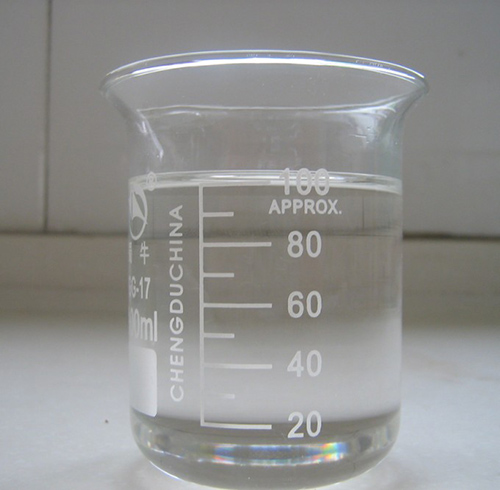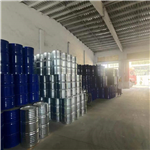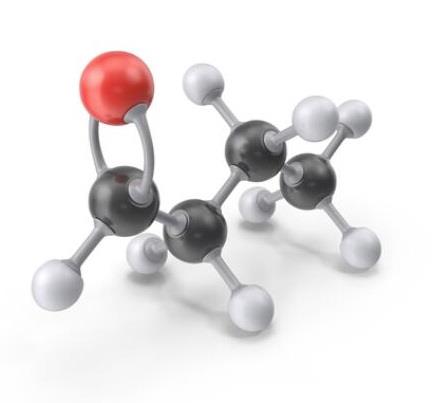The preparation of butyraldehyde
Background
Butyraldehyde is a colorless, transparent, flammable liquid with a suffocating aldehyde odor. Slightly soluble in water, miscible with ethanol, ether, ethyl acetate, acetone, toluene and many other organic solvents and oils. This ingredient is found in many essential oils such as flowers, leaves, fruits, grasses, dairy products, and alcohol in nature, as well as in flue-cured tobacco leaves, mainstream smoke, and sidestream smoke. Extreme dilution has an ethereal fragrance. It is mainly used for organic synthesis, and it is also the raw material for the manufacture of spices[1].

Picture 1 Butyraldehyde liquid
Hazardous properties
Butyraldehyde is flammable, and its vapor can form an explosive gas when mixed with air, which is easily oxidized to butyric acid in the air. It is flammable, and can react with strong oxidants and many substances such as oxidation, reduction, condensation, etc., and polymerize to form epoxides, which can undergo addition reactions with olefins, alcohols, ammonia and their derivatives.
Toxicological data
1. Toxicity classification: poisoning
2. Acute toxicity: oral-rat LD50: 2490 mg/kg; intraperitoneal-mouse LD50: 1140 mg/kg.
3. Irritation data: skin-rabbit 500mg/24h severe; eyes-rabbit 75 μg severe.
4. n-Butyraldehyde is moderately irritating to the skin of mice, and seriously irritating to the eyes of rabbits. If the product is applied to the skin of rabbits, it can cause severe irritation. The butyraldehyde concentration 4 petrolatum formulation showed no sensitization in human skin tests. The undiluted sample, however, was moderately irritating to the skin.
5. Butyraldehyde is a low toxicity category. Irritating to skin and eyes.
Preparation
1. Propylene Oxosynthesis Method Propylene and synthesis gas undergo an oxo reaction in the presence of a Co or Rh catalyst to generate n-butyraldehyde and isobutyraldehyde. Due to the different catalysts and process conditions used, it can be divided into a high-pressure oxo synthesis method using cobalt carbonyl as a catalyst and a low-pressure oxo synthesis method using a carbonyl rhodium phosphine complex as a catalyst. The high pressure method (140~180℃, 19.6~34.3MPa) has high reaction pressure and many by-products, thus increasing the production cost. Low pressure (90~120℃, 1.96MPa) oxo synthesis method has low reaction pressure, normal isomer ratio of 8-10:1, few by-products, high conversion rate, low raw material, low power consumption, simple equipment, short process, It has shown excellent economic effects and developed rapidly.
2. Acetaldehyde condensation method, reaction chemical formula
3. Butanol oxidative dehydrogenation method Using silver as a catalyst, butanol is oxidized by air in one step, and then the reactants are condensed, separated and rectified to obtain the finished product.
4. Preparation method: In a reaction flask equipped with a fractionation device (the receiving flask is cooled with an ice-water bath) and a dropping funnel (the bottom extends into the bottom of the flask), add positive (2) 41 g (0.55 mol) and a few zeolite, and heat to boiling. A solution prepared by potassium dichromate 56g (0.188mol), 300mL of water and 40mL of concentrated sulfuric acid was added dropwise, and the addition was completed in about 20min. Keep the reaction system boiling, and the temperature at the top of the fractionation column does not exceed 85 °C. When all the oxidants are added, continue the reaction for 15 min, and collect fractions below 90 °C. Water was separated from the eluate, dried over anhydrous sodium sulfate, fractionated, and the fractions at 73-76°C were collected to obtain 13 g of n-butyraldehyde (1) with a yield of 32%.
Application
1. Butyraldehyde is an important intermediate. n-Butanol can be prepared by hydrogenation of n-butyraldehyde; 2-ethylhexanol can be prepared by condensation dehydration and then hydrogenation, and n-butanol and 2-ethylhexanol are the main raw materials of plasticizer. Oxidation of n-butyraldehyde can produce n-butyric acid; condensation with formaldehyde can produce trimethylolpropane, which is a plasticizer for synthesizing alkyd resin and raw material for air drying oil; condensation with phenol to produce oil-soluble resin; and urea Condensation can produce alcohol-soluble resin; the products condensed with polyvinyl alcohol; butylamine; The condensate is used as celluloid; resin; solvent for rubber and pharmaceutical products; pharmaceutical industry is used to make "Mianertong"; "pyrimethamine"; methamphetamine, etc. Plasticizers, synthetic resins, rubber accelerators, pesticides and other important intermediate raw materials.
2. Butyraldehyde is an important chemical raw material. It is also used in the preparation of flavors and fragrances. It is contained in various essential oils such as flowers, leaves, fruits, grasses, dairy products, and alcohol in nature. [Food additive usage limit (mg/kg): soft drink 0.71; cold drink 4.8; Candy 2.9; baked goods 5.4; alcohol 0.50; sugar 0.25. ]. It is usually diluted before adding the essence, which has a certain effect on coordinating and increasing the elegance of the top fragrance.
3. Can be used as anesthetic and stimulant.
Dangerous
Hazard class: Class 3.2, medium flash point liquid
Routes of entry: inhalation, ingestion, skin absorption
Health Hazards: Strong irritation to eyes, respiratory mucous membranes and skin. Inhalation can cause inflammation, edema and spasm of the larynx and bronchi, chemical pneumonitis, pulmonary edema, and anesthesia. Long-term or repeated exposure to individual sensitive individuals can cause allergic reactions.
Environmental hazards: can cause pollution to water and soil
Explosion hazard: This product is flammable, and its vapor and air can form an explosive mixture, which can cause combustion and explosion in case of open fire and high heat energy. Reacts violently in contact with oxidants. In case of high heat, a polymerization reaction can occur, releasing a large amount of heat and causing container rupture and explosion accidents. Its vapor is heavier than air, and can spread to a considerable distance at a lower place.
Hazardous combustion products: carbon monoxide.
First-aid
Skin Contact: Remove contaminated clothing and rinse skin thoroughly with soap and water. If you feel unwell, seek medical attention.
Eye Contact: Immediately lift the eyelids and rinse thoroughly with plenty of running water or saline. If you feel unwell, seek medical attention.
Inhalation: Quickly leave the scene to fresh air. Keep the airway open. If breathing is difficult, give oxygen. If breathing stops, give artificial respiration immediately. seek medical attention.
Ingestion: Rinse mouth. If you feel unwell, seek medical attention.
Fire-fighting measures
Extinguishing methods: Anti-solvent foam, dry powder, carbon dioxide, sand to extinguish fire.
Fire-fighting precautions and measures: Firefighters must wear gas masks and full-body fire-fighting suits to put out the fire in the upwind direction. Move the container from the fire to an open area as much as possible, and spray water to keep the fire container cool until the fire is over. If the container suddenly makes an abnormal noise or has abnormal phenomena, it should be evacuated immediately. Fire extinguishing with water is ineffective.
Emergency release treatment
Emergency treatment: quickly evacuate the personnel from the leaked contaminated area to a safe area, isolate them, and strictly restrict access. Cut off the source of ignition. It is recommended that emergency personnel wear self-contained positive pressure breathing apparatus, anti-static overalls, and rubber gloves. All operating equipment should be grounded, and it is forbidden to cross or touch leaks. Cut off sources of leaks as much as possible. Prevent flow into restricted spaces such as sewers and flood drains.
Small spills: Absorb with sand or other inert material. Use clean, non-sparking tools to collect absorbent material.
Large spills: Construct dikes or dig pits for containment. Absorb large quantities of liquids with sand, inert substances and vermiculite. Cover with solvent resistant foam to reduce evaporation but not flammability of spillage in confined spaces. Transfer it to a tanker or a special collector with an explosion-proof pump.
Operation disposal
Operation precautions: closed operation, full ventilation. Operators must undergo special training and strictly abide by operating procedures. It is recommended that operators wear self-priming filter respirators (full face masks), anti-static work clothes and rubber gloves. Keep away from fire and heat sources, and smoking is strictly prohibited in the workplace. Use explosion-proof ventilation systems and equipment. Prevent vapors from leaking into the workplace air. Avoid contact with oxidizing agents, reducing agents and alkalis. Filling should control the flow rate to prevent the accumulation of static electricity. When handling, it should be lightly loaded and unloaded to prevent damage to packaging and containers. Equipped with the corresponding variety and quantity of fire fighting equipment and leakage emergency treatment equipment. Empty containers may be harmful residues.
Storage methods
1. Packed in stainless steel barrels or aluminum barrels lined with polyethylene, weighing 100kg or 40kg. Storage and transportation according to the regulations of flammable and toxic chemicals. Store in a low-temperature ventilated place, away from flames and oxidants.
2. Storage precautions: Store in a cool, ventilated warehouse. Keep away from fire and heat sources. This product should be sealed and stored below 30°C. Stainless steel storage, canned transportation. The packaging is required to be sealed and not in contact with the air. It should be stored separately from oxidants, reducing agents, alkalis, etc., and should not be mixed. Use explosion-proof lighting and ventilation facilities. Prohibit the use of mechanical equipment and tools that are prone to sparks. Storage areas should be equipped with emergency release equipment and suitable containment materials.
Reference
1 Zhang Jianchen, Guo Kunmin, Ma Lan, Zhao Hongyang. Mechanism of gas-phase photocatalytic degradation of benzene and butyraldehyde by TiO2/AC composite photocatalyst. 2006
You may like
Related articles And Qustion
See also
Lastest Price from Butyraldehyde manufacturers

US $10.00/kg2025-04-21
- CAS:
- 123-72-8
- Min. Order:
- 1kg
- Purity:
- 99%
- Supply Ability:
- 100 mt

US $9.00/KG2024-10-11
- CAS:
- 123-72-8
- Min. Order:
- 1KG
- Purity:
- 99.8%
- Supply Ability:
- 100tons



